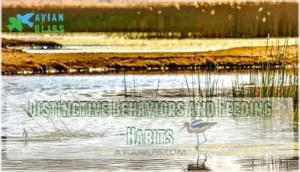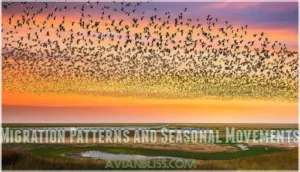This site is supported by our readers. We may earn a commission, at no cost to you, if you purchase through links.

Black and white wings flash against cinnamon-washed plumage during breeding season, while impossibly long blue-gray legs carry it through alkaline lakes and coastal flats across North America.
Unlike many wetland species that struggle with habitat loss, avocets have shown exceptional resilience—their populations actually increased over 3% annually between 2005 and 2015. Understanding their specialized adaptations and habitat needs reveals why these birds thrive where others can’t, and what threats still loom despite their current success.
Table Of Contents
- Key Takeaways
- What is The American Avocet?
- Distinctive Behaviors and Feeding Habits
- Habitat Preferences and Geographic Range
- Breeding, Nesting, and Life Cycle
- Conservation Status and Protection Efforts
- Frequently Asked Questions (FAQs)
- Are American avocets rare?
- Where are American avocet found?
- What are some interesting facts about the American avocet?
- Do American avocets mate for life?
- How long do American Avocets typically live?
- What are the main predators of American Avocets?
- What do American Avocet eggs look like?
- Are American Avocets aggressive toward other birds?
- Can American Avocets swim or dive underwater?
- What predators threaten American Avocet populations?
- Conclusion
Key Takeaways
- The American Avocet‘s upturned bill functions like a precision scythe, sweeping side-to-side through shallow water to detect prey by touch rather than sight—a specialized feeding technique that sets it apart from other shorebirds.
- Despite widespread habitat loss affecting many wetland species, American Avocet populations increased over 3% annually between 2005 and 2015, demonstrating exceptional resilience in alkaline lakes and coastal flats where few competitors can survive.
- These birds thrive in harsh, open alkaline environments that most species avoid, breeding in semicolonial groups across western and mid-western North America before migrating to southern coastal wetlands for winter.
- While currently classified as Least Concern with stable populations of around 450,000 birds, ongoing threats from wetland drainage, climate change, and pollution mean their future depends entirely on continued habitat protection and restoration efforts.
What is The American Avocet?
You’re about to meet one of the West’s most striking shorebirds—a creature that wades through shallow waters with an unmistakable sweeping motion. The American Avocet isn’t just another waterbird; it’s a master of adaptation with features that set it apart from anything else on the mudflats.
Here’s what makes this species worth knowing, from its scientific placement to the physical traits that catch your eye from a distance.
Taxonomy and Classification
The American Avocet carries the scientific name Recurvirostra americana, placing it within a specialized lineage of shorebirds. This avian species belongs to the family Recurvirostridae, which includes stilts and avocets known for their striking bills and wading adaptations.
Understanding bird phylogeny reveals how classification systems group this species alongside relatives sharing evolutionary relationships. Ornithology research shows taxonomic history traces these birds through distinctive morphological traits, making species identification straightforward for those studying avian species across wetland ecosystems.
The conservation status of the American Avocet is closely tied to its breeding habitat needs, which play a vital role in its survival.
Physical Description and Unique Features
You’ll recognize this elegant wader by its signature upturned bill—a precision tool curved skyward like a delicate scythe. Long bluish-gray legs support an oval body marked by a striking black and white striped pattern across the back and wings.
Head plumage shifts from grayish-white to rusty cinnamon come breeding season, transforming body proportions into a canvas of seasonal change. These American Avocet characteristics make field identification straightforward.
Size and Shape Comparison to Other Birds
When placed next to similar waders, this species hits a perfect balance—larger than the slender Black-necked Stilt but noticeably smaller than a Snowy Egret. Think robin-to-crow range for relative size. You’re looking at 17 to 18.5 inches in length with a wingspan pushing 28 inches.
Body proportions center on that distinctive bill shape and leg length—features that nail bird species identification every time.
Distinctive Behaviors and Feeding Habits
If you want to understand what makes the American Avocet stand out, you need to see how it moves and feeds.
These birds don’t just wade around—they’ve developed specific techniques that separate them from other shorebirds.
Here’s what to watch for when you’re observing their distinctive behaviors.
Foraging Techniques and Bill Usage
The American Avocet’s upturned bill works like a fine-tooth rake, sweeping through shallow water to snag insects and crustaceans that most other shorebirds can’t reach. You’ll see them leaning forward, bill submerged, filtering tiny food items by touch rather than sight.
The American Avocet’s upturned bill sweeps through shallow water like a fine-tooth rake, filtering insects and crustaceans by touch alone
This bill anatomy allows specialized foraging methods—sweeping side-to-side in rhythmic arcs. Their water filtering technique catches midge larvae, brine shrimp, and aquatic insects with striking precision.
These feeding strategies showcase how avian behavior adjusts to specific food detection needs in alkaline wetlands.
Flocking and Social Behaviors
Watch a flock sweep across shallow water like synchronized swimmers, heads swinging left and right in perfect rhythm—that’s the American Avocet’s signature group feeding display. These shorebird characteristics reveal tight group coordination during foraging strategies.
Migratory flocks form semicolonial breeding groups, while avian behavior shows their social structure adapts from paired territories to cooperative winter feeding.
Bird migration patterns bring hundreds together on coastal flats, where flock dynamics optimize food detection through coordinated movement.
Vocalizations and Communication
Listen close to a feeding colony and you’ll hear their alarm system in action—a sharp, urgent "wheep" that ripples through the group like a warning bell. This vocalization cuts through sound waves across wetlands, alerting the entire flock to danger.
American Avocet call patterns differ from complex bird songs—they’re direct signals rather than vocal learning displays. Their avian communication style stays consistent year-round, making these bird species characteristics reliable for field identification.
Habitat Preferences and Geographic Range
Understanding where American Avocets make their home opens a window into their extraordinary adaptability. These elegant shorebirds don’t settle for just any patch of water—they seek out specific environments that meet their unique needs.
Let’s explore the habitats they prefer, where they raise their young, and how they navigate the continent with the seasons.
Preferred Wetland and Shoreline Habitats
You’ll find American Avocets where the water meets wide-open sky—places most shorebirds would pass up for something more sheltered. These birds thrive in open, exposed aquatic landscapes where alkaline lakes and coastal habitats dominate:
- Shallow alkaline wetlands with minimal vegetation provide ideal foraging grounds
- Beaches and tidal flats offer access to invertebrates in coastal habitats
- Salty or alkaline lakes attract them more than freshwater wetland ecosystems
- Bare shoreline ecology zones where they can spot predators from far off
Breeding and Nesting Locations
When spring calls, these birds head to the heartland of alkali and salt—a breeding range that stretches across the western and mid-western reaches of North America.
You’ll spot nesting colonies near iconic wetland sanctuaries like the Great Salt Lake in Utah and California’s Tulare Basin, where shoreline nests dot the landscape during breeding season.
| Region | Key Nesting Grounds |
|---|---|
| Utah | Great Salt Lake alkali flats |
| California | San Francisco Bay, Tulare Basin |
| Prairie Pothole | Scattered wetland breeding colonies |
| Mid-West | Shallow alkaline pools |
Migration Patterns and Seasonal Movements
Migration timing tells a story written in the rhythm of seasons. As summer fades, these shorebirds leave their alkaline breeding grounds and trace well-worn flyways south to coastal and interior wetlands stretching from the southern U.S. through Mexico. Understanding avocet migration reveals how habitat connectivity sustains entire populations during their seasonal routes. The American Avocet’s unique breeding territory habits play a vital role in their migration patterns.
- Fall departure begins when breeding wraps up, pulling birds toward warmer coastlines
- Winter havens dot the southern and southwestern states, offering rich feeding grounds
- Spring return kicks off early as pairs form and cinnamon plumage emerges
- Stopover sites along the flyway provide critical rest and refueling during shorebird migration patterns
Breeding, Nesting, and Life Cycle
American Avocets follow a fascinating reproductive cycle that begins with courtship rituals in early spring. You’ll find these birds are surprisingly devoted parents, building nests in colonies and working together to protect their young.
Let’s break down how these elegant shorebirds bring the future offspring into the world.
Mating Displays and Pair Formation
You can’t mistake the courtship ritual of an American Avocet—it’s like watching a carefully choreographed dance where both partners know exactly when to bow, step, and circle around each other. These monogamous birds form pair bonds during early spring migration through elaborate breeding behaviors.
| Display Type | Purpose |
|---|---|
| Circle display | Mate selection demonstration |
| Bill crossing | Strengthen pair bonding |
| Synchronized preening | Reinforce partnership |
| Water splashing | Signal breeding readiness |
The courtship rituals peak as the breeding season approaches, with both avocets performing the intricate circle display repeatedly until their bond solidifies.
Nest Site Selection and Construction
Once the pair bond clicks into place, these avocets don’t waste time—they scout for nest sites in bare, open areas near shallow water, often grouping loosely with other breeding pairs. Colony formation provides safety during the breeding season. Their nest architecture stays simple:
- A shallow scrape in soil or sand
- Sometimes built up into mounds over a foot tall
- Minimal nesting materials like grass stems or pebbles
Site selection favors alkaline flats where predators can’t approach unseen—a smart strategy for shorebird characteristics and behavior that aids American Avocet conservation.
Parental Care and Chick Development
After the eggs hatch, both parents guard their downy chicks with fierce determination, leading them to feeding spots within hours of breaking free from the shell. Chick rearing demands constant vigilance—the parents use distraction displays to lure predators away from the nest.
These precocial fledglings can swim and feed themselves within days, but parental bonds remain strong. Brood survival depends on safe Avocet habitat and migration routes that support this critical period.
Conservation Status and Protection Efforts
The American Avocet’s future depends on how well we protect the wetlands they need to survive. While their numbers remain stable for now, these birds face real challenges from habitat loss and changing ecosystems.
Here’s what you need to know about their conservation status and the work being done to keep them thriving.
Current Population Trends and IUCN Status
The American Avocet is classified as Least Concern by the IUCN as of 2025. Global estimates stand at 460,000 individuals, with North America home to roughly 450,000 birds. Population trends show notable resilience: after a minor decline from 1966–2015, numbers surged 3.25% annually between 2005 and 2015. You’ll find this species thriving across expanding ranges, particularly in eastern regions where populations have grown notably.
- Stable Status: NatureServe assigns a G5 rank, meaning globally secure
- Regional Growth: Eastern U.S. wintering and migrant numbers increased dramatically in recent decades
- Federal Protection: Migratory Bird Treaty Act coverage since 1918 aids recovery
- Breeding Stronghold: High proportion nests in North Dakota’s Prairie Pothole Region
- Climate Vulnerability: Species faces future threats from western wetland changes despite current stability
Threats From Habitat Loss and Pollution
Despite current stability, habitat loss and wetland degradation threaten the American Avocet’s future. Development drains shallow alkaline lakes critical for breeding and foraging. Climate change alters western wetlands, disrupting migration patterns.
Pollution effects compound these pressures—pesticides leach into feeding grounds, causing toxic exposure that impacts reproduction.
Wetland conservation isn’t just about preserving habitat; it’s about protecting the ecological balance these birds need to survive.
Ongoing Conservation Initiatives and How to Help
Major conservation efforts include wetland restoration projects like South Bay Salt Pond, which converted 15,100 acres to tidal marsh directly supporting American Avocets. Conservation funding through the North American Wetland Conservation Act provides millions for habitat protection.
You can help through community engagement—report sightings on eBird, volunteer for monitoring programs, or support bird species conservation through donations.
Sustainable practices matter too: plant native vegetation, avoid pesticides, and advocate for wildlife conservation policies protecting avian conservation priorities.
Frequently Asked Questions (FAQs)
Are American avocets rare?
No, they’re not rare—ironically, their population stability and range expansion tell a success story. Eastern sightings have increased dramatically in recent decades. Conservation efforts work.
The Avocet species thrives in suitable wetlands, showing regional abundance where habitat persists.
Where are American avocet found?
These shorebirds inhabit western and mid-western North America during the breeding season, nesting in shallow alkaline wetlands from the Great Salt Lake to San Francisco Bay.
Come winter, they migrate to coastal and interior wetlands across the southern United States and Mexico.
What are some interesting facts about the American avocet?
These shorebirds swap plumage from gray to cinnamon each spring and sweep their unique bills side-to-side in unison feeding displays. They thrive in salty alkaline waters.
Their population increase reflects successful adaptation to western wetlands.
Do American avocets mate for life?
Do lifetime partnerships exist in shorebirds, or is breeding fidelity more flexible? American Avocets don’t mate for life. Pair bond duration lasts one breeding season.
Mate switching occurs between years, though divorce rates vary by habitat conditions and breeding success.
How long do American Avocets typically live?
Longevity studies in ornithology show most bird species face high mortality rates early in life. For this particular species, survival tactics and habitat quality heavily influence age distribution.
You’ll find American Avocets generally live around nine years in the wild.
What are the main predators of American Avocets?
You’ll find various threats lurking around wetlands, from the sky to the ground. American Avocet predators include coyotes, foxes, gulls, ravens, and raptors targeting eggs and chicks, while adults face aerial hunters like falcons.
What do American Avocet eggs look like?
You’ll spot olive-buff colored eggs speckled with dark brown or black markings. Each clutch usually holds three to four pyriform (pear-shaped) eggs laid in a simple scrape nest.
The mottled pattern provides camouflage during the 23-25 day incubation period.
Are American Avocets aggressive toward other birds?
Yes, you’ll notice territorial defense during breeding season. These shorebirds show agonistic behavior when protecting nest sites, engaging in avian conflicts through loud calls and aggressive displays.
Their social interactions shift from tolerant to defensive when boundaries matter most.
Can American Avocets swim or dive underwater?
American Avocets can swim competently but don’t dive underwater. Their buoyancy control keeps them afloat while feeding in shallow water.
These shorebirds wade rather than plunge, using swimming techniques only when water depth requires floating instead of wading.
What predators threaten American Avocet populations?
Predators like coyotes, foxes, and gulls raid nests for eggs and chicks. Hawks and falcons hunt adult birds.
Nest predators threaten habitat security, shaping predator-prey dynamics and avian behavior throughout breeding seasons.
Conclusion
The American avocet thrives in harsh alkaline waters where few competitors survive, yet it can’t exist without the very wetlands humans continue to drain—a paradox that defines its future.
You’ve seen how this bird’s upturned bill, cooperative nesting, and adaptable nature create success stories across North America. But resilience has limits.
Protecting shallow wetlands, reducing pesticide runoff, and supporting habitat restoration guarantees these elegant waders won’t become another conservation cautionary tale. Their increasing numbers prove that when we prioritize what they need, both species and wild places flourish.
- https://abcbirds.org/bird/american-avocet/
- https://explorer.natureserve.org/Taxon/ELEMENT_GLOBAL.2.100007/Recurvirostra_americana
- https://www.audubon.org/field-guide/bird/american-avocet
- https://www.eastsideaudubon.org/corvid-crier/2024/5/american-avocet
- https://whsrn.org/wp-content/uploads/2019/03/colwell-et-al.-2001.pdf









